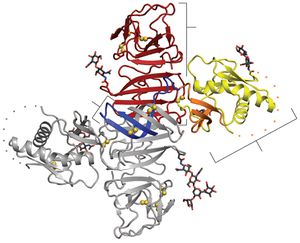Flavivirus NS1 protein: Difference between revisions
From MicrobeWiki, the student-edited microbiology resource
| Line 27: | Line 27: | ||
==NS1 Structure== | ==NS1 Structure== | ||
[[Image:Alex Fig 2.jpeg|thumb| | [[Image:Alex Fig 2.jpeg|thumb|300px|left|Figure 2. NS1 dimer structure. (A) NS1 dimer with one subunit in gray andthe other colored by domain (blue, b roll; yellow, wing with orange connectorsubdomain; red, central b ladder). Disulfides are shown as yellow spheresand N-linked glycosylation sites as black sticks. A 20-residue disordered regions indicated with dotted lines. C, C terminus; N, N terminus.(Akey et al 2014). ]] | ||
==NS1 Expression, post translational processing and trafficking == | |||
[[Image:Alex Fig 3.jpeg|thumb|400px|left|Figure 3. Fig. 1. Schematic summary of NS1 trafficking in mammalian cells. ]] | |||
Revision as of 04:28, 22 April 2014
Introduction
By [Student Name]
At right is a sample image insertion. It works for any image uploaded anywhere to MicrobeWiki. The insertion code consists of:
Double brackets: [[
Filename: PHIL_1181_lores.jpg
Thumbnail status: |thumb|
Pixel size: |300px|
Placement on page: |right|
Legend/credit: Electron micrograph of the Ebola Zaire virus. This was the first photo ever taken of the virus, on 10/13/1976. By Dr. F.A. Murphy, now at U.C. Davis, then at the CDC.
Closed double brackets: ]]
Other examples:
Bold
Italic
Subscript: H2O
Superscript: Fe3+
Introduce the topic of your paper. What microorganisms are of interest? Habitat? Applications for medicine and/or environment?
Flavivirus
By Alex Gonzales
Flavivirus Structure

Figure 1. Flavivirus Structure. (A) Schematic representation of a flavivirus particle. Left: immature virion; right: mature virion. The unstructured spherical capsid contains the positive-stranded genomic RNA and multiple copies of the capsid protein C. Immature virions are covered by spiky complexes of 60 trimers of prM-E heterodimers. The proteolytic cleavage of prM results in the reorganization of the E proteins and the formation of smooth-surfaced particles covered with 90 E dimers. sE: soluble form of E that lacks the membrane anchor and an adjacent sequence element called ‘stem’. M: Membrane-associated cleavage product of prM. (B) Herringbone-like arrangement of90 E protein dimers at the virion surface as determined by cryo-electron microscopy .
NS1 Structure

Figure 2. NS1 dimer structure. (A) NS1 dimer with one subunit in gray andthe other colored by domain (blue, b roll; yellow, wing with orange connectorsubdomain; red, central b ladder). Disulfides are shown as yellow spheresand N-linked glycosylation sites as black sticks. A 20-residue disordered regions indicated with dotted lines. C, C terminus; N, N terminus.(Akey et al 2014).


